+ Open data
Open data
- Basic information
Basic information
| Entry | Database: PDB / ID: 6zaz | ||||||
|---|---|---|---|---|---|---|---|
| Title | Fructo-oligosaccharide transporter BT 1762-63 | ||||||
 Components Components |
| ||||||
 Keywords Keywords | MEMBRANE PROTEIN / Outer membrane protein TonB-dependent transporter SusC SusD Levan Bacteroides thetaiotaomicron | ||||||
| Function / homology |  Function and homology information Function and homology information | ||||||
| Biological species |  Bacteroides thetaiotaomicron (bacteria) Bacteroides thetaiotaomicron (bacteria) | ||||||
| Method |  X-RAY DIFFRACTION / X-RAY DIFFRACTION /  SYNCHROTRON / SYNCHROTRON /  MOLECULAR REPLACEMENT / Resolution: 2.69 Å MOLECULAR REPLACEMENT / Resolution: 2.69 Å | ||||||
 Authors Authors | van den Berg, B. | ||||||
| Funding support |  United Kingdom, 1items United Kingdom, 1items
| ||||||
 Citation Citation |  Journal: Nat Commun / Year: 2021 Journal: Nat Commun / Year: 2021Title: Insights into SusCD-mediated glycan import by a prominent gut symbiont. Authors: Declan A Gray / Joshua B R White / Abraham O Oluwole / Parthasarathi Rath / Amy J Glenwright / Adam Mazur / Michael Zahn / Arnaud Baslé / Carl Morland / Sasha L Evans / Alan Cartmell / ...Authors: Declan A Gray / Joshua B R White / Abraham O Oluwole / Parthasarathi Rath / Amy J Glenwright / Adam Mazur / Michael Zahn / Arnaud Baslé / Carl Morland / Sasha L Evans / Alan Cartmell / Carol V Robinson / Sebastian Hiller / Neil A Ranson / David N Bolam / Bert van den Berg /   Abstract: In Bacteroidetes, one of the dominant phyla of the mammalian gut, active uptake of large nutrients across the outer membrane is mediated by SusCD protein complexes via a "pedal bin" transport ...In Bacteroidetes, one of the dominant phyla of the mammalian gut, active uptake of large nutrients across the outer membrane is mediated by SusCD protein complexes via a "pedal bin" transport mechanism. However, many features of SusCD function in glycan uptake remain unclear, including ligand binding, the role of the SusD lid and the size limit for substrate transport. Here we characterise the β2,6 fructo-oligosaccharide (FOS) importing SusCD from Bacteroides thetaiotaomicron (Bt1762-Bt1763) to shed light on SusCD function. Co-crystal structures reveal residues involved in glycan recognition and suggest that the large binding cavity can accommodate several substrate molecules, each up to ~2.5 kDa in size, a finding supported by native mass spectrometry and isothermal titration calorimetry. Mutational studies in vivo provide functional insights into the key structural features of the SusCD apparatus and cryo-EM of the intact dimeric SusCD complex reveals several distinct states of the transporter, directly visualising the dynamics of the pedal bin transport mechanism. | ||||||
| History |
|
- Structure visualization
Structure visualization
| Structure viewer | Molecule:  Molmil Molmil Jmol/JSmol Jmol/JSmol |
|---|
- Downloads & links
Downloads & links
- Download
Download
| PDBx/mmCIF format |  6zaz.cif.gz 6zaz.cif.gz | 606.4 KB | Display |  PDBx/mmCIF format PDBx/mmCIF format |
|---|---|---|---|---|
| PDB format |  pdb6zaz.ent.gz pdb6zaz.ent.gz | 491.3 KB | Display |  PDB format PDB format |
| PDBx/mmJSON format |  6zaz.json.gz 6zaz.json.gz | Tree view |  PDBx/mmJSON format PDBx/mmJSON format | |
| Others |  Other downloads Other downloads |
-Validation report
| Summary document |  6zaz_validation.pdf.gz 6zaz_validation.pdf.gz | 1.6 MB | Display |  wwPDB validaton report wwPDB validaton report |
|---|---|---|---|---|
| Full document |  6zaz_full_validation.pdf.gz 6zaz_full_validation.pdf.gz | 1.6 MB | Display | |
| Data in XML |  6zaz_validation.xml.gz 6zaz_validation.xml.gz | 54.9 KB | Display | |
| Data in CIF |  6zaz_validation.cif.gz 6zaz_validation.cif.gz | 76.4 KB | Display | |
| Arichive directory |  https://data.pdbj.org/pub/pdb/validation_reports/za/6zaz https://data.pdbj.org/pub/pdb/validation_reports/za/6zaz ftp://data.pdbj.org/pub/pdb/validation_reports/za/6zaz ftp://data.pdbj.org/pub/pdb/validation_reports/za/6zaz | HTTPS FTP |
-Related structure data
| Related structure data |  6ytcC  6z8iC  6z9aC  6zltC  6zluC  6zm1C  5t3rS C: citing same article ( S: Starting model for refinement |
|---|---|
| Similar structure data |
- Links
Links
- Assembly
Assembly
| Deposited unit | 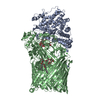
| ||||||||
|---|---|---|---|---|---|---|---|---|---|
| 1 | 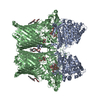
| ||||||||
| Unit cell |
|
- Components
Components
-Protein , 2 types, 2 molecules AB
| #1: Protein | Mass: 66142.625 Da / Num. of mol.: 1 Source method: isolated from a genetically manipulated source Source: (gene. exp.)  Bacteroides thetaiotaomicron (strain ATCC 29148 / DSM 2079 / NCTC 10582 / E50 / VPI-5482) (bacteria) Bacteroides thetaiotaomicron (strain ATCC 29148 / DSM 2079 / NCTC 10582 / E50 / VPI-5482) (bacteria)Production host:  Bacteroides thetaiotaomicron (bacteria) / References: UniProt: Q8A6W4 Bacteroides thetaiotaomicron (bacteria) / References: UniProt: Q8A6W4 |
|---|---|
| #2: Protein | Mass: 115483.602 Da / Num. of mol.: 1 / Source method: isolated from a natural source Source: (natural)  Bacteroides thetaiotaomicron (strain ATCC 29148 / DSM 2079 / NCTC 10582 / E50 / VPI-5482) (bacteria) Bacteroides thetaiotaomicron (strain ATCC 29148 / DSM 2079 / NCTC 10582 / E50 / VPI-5482) (bacteria)References: UniProt: Q8A6W3 |
-Sugars , 2 types, 2 molecules
| #3: Polysaccharide | beta-D-fructofuranose-(2-6)-beta-D-fructofuranose-(2-6)-beta-D-fructofuranose-(2-6)-[beta-D- ...beta-D-fructofuranose-(2-6)-beta-D-fructofuranose-(2-6)-beta-D-fructofuranose-(2-6)-[beta-D-fructofuranose-(2-1)]beta-D-fructofuranose-(2-6)-beta-D-fructofuranose-(2-6)-beta-D-fructofuranose Source method: isolated from a genetically manipulated source |
|---|---|
| #4: Polysaccharide | beta-D-fructofuranose-(2-1)-beta-D-fructofuranose-(2-6)-beta-D-fructofuranose-(2-6)-beta-D-fructofuranose Source method: isolated from a genetically manipulated source |
-Non-polymers , 4 types, 249 molecules 

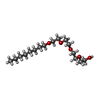




| #5: Chemical | ChemComp-CL / | ||||
|---|---|---|---|---|---|
| #6: Chemical | | #7: Chemical | #8: Water | ChemComp-HOH / | |
-Details
| Has ligand of interest | Y |
|---|---|
| Has protein modification | Y |
-Experimental details
-Experiment
| Experiment | Method:  X-RAY DIFFRACTION / Number of used crystals: 1 X-RAY DIFFRACTION / Number of used crystals: 1 |
|---|
- Sample preparation
Sample preparation
| Crystal | Density Matthews: 3.65 Å3/Da / Density % sol: 66.33 % |
|---|---|
| Crystal grow | Temperature: 293 K / Method: vapor diffusion, hanging drop Details: 0.15 M sodium formate 0.1 M Hepes pH 7-7.5 16-20% PEG3350 |
-Data collection
| Diffraction | Mean temperature: 100 K / Serial crystal experiment: N |
|---|---|
| Diffraction source | Source:  SYNCHROTRON / Site: SYNCHROTRON / Site:  Diamond Diamond  / Beamline: I04 / Wavelength: 0.978 Å / Beamline: I04 / Wavelength: 0.978 Å |
| Detector | Type: DECTRIS PILATUS 6M / Detector: PIXEL / Date: Jun 25, 2016 |
| Radiation | Protocol: SINGLE WAVELENGTH / Monochromatic (M) / Laue (L): M / Scattering type: x-ray |
| Radiation wavelength | Wavelength: 0.978 Å / Relative weight: 1 |
| Reflection | Resolution: 2.69→170.5 Å / Num. obs: 67688 / % possible obs: 100 % / Redundancy: 7.2 % / CC1/2: 0.99 / Rpim(I) all: 0.085 / Net I/σ(I): 6 |
| Reflection shell | Resolution: 2.69→2.74 Å / Mean I/σ(I) obs: 1.1 / Num. unique obs: 3382 / CC1/2: 0.6 / Rpim(I) all: 0.61 |
- Processing
Processing
| Software |
| |||||||||||||||||||||||||||||||||||||||||||||||||||||||||||||||||||||||||||
|---|---|---|---|---|---|---|---|---|---|---|---|---|---|---|---|---|---|---|---|---|---|---|---|---|---|---|---|---|---|---|---|---|---|---|---|---|---|---|---|---|---|---|---|---|---|---|---|---|---|---|---|---|---|---|---|---|---|---|---|---|---|---|---|---|---|---|---|---|---|---|---|---|---|---|---|---|
| Refinement | Method to determine structure:  MOLECULAR REPLACEMENT MOLECULAR REPLACEMENTStarting model: 5T3R Resolution: 2.69→106.826 Å / SU ML: 0.49 / Cross valid method: FREE R-VALUE / σ(F): 1.33 / Phase error: 32.47 / Stereochemistry target values: ML
| |||||||||||||||||||||||||||||||||||||||||||||||||||||||||||||||||||||||||||
| Solvent computation | Shrinkage radii: 0.9 Å / VDW probe radii: 1.11 Å / Solvent model: FLAT BULK SOLVENT MODEL | |||||||||||||||||||||||||||||||||||||||||||||||||||||||||||||||||||||||||||
| Refinement step | Cycle: LAST / Resolution: 2.69→106.826 Å
| |||||||||||||||||||||||||||||||||||||||||||||||||||||||||||||||||||||||||||
| Refine LS restraints |
| |||||||||||||||||||||||||||||||||||||||||||||||||||||||||||||||||||||||||||
| Refinement TLS params. | Method: refined / Refine-ID: X-RAY DIFFRACTION
| |||||||||||||||||||||||||||||||||||||||||||||||||||||||||||||||||||||||||||
| Refinement TLS group |
|
 Movie
Movie Controller
Controller







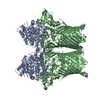



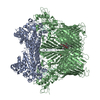
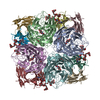

 PDBj
PDBj







